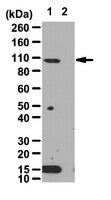The organic solute transporters alpha and beta are induced by hypoxia in human hepatocytes.
Schaffner, CA; Mwinyi, J; Gai, Z; Thasler, WE; Eloranta, JJ; Kullak-Ublick, GA
Liver international : official journal of the International Association for the Study of the Liver
35
1152-61
2015
Show Abstract
The organic solute transporters alpha and beta (OSTα-OSTβ) form a heterodimeric transporter located at the basolateral membrane of intestinal epithelial cells and hepatocytes. Liver injury caused by ischaemia-reperfusion, cancer, inflammation or cholestasis can induce a state of hypoxia in hepatocytes. Here, we studied the effect of hypoxia on the expression of OSTα-OSTβ.OSTα-OSTβ expression was measured in Huh7 cells and primary human hepatocytes (PHH) exposed to chenodeoxycholic acid (CDCA), hypoxia or both. OSTα-OSTβ promoter activity was analysed in luciferase reporter gene assays. Binding of hypoxia-inducible factor-1 alpha (HIF-1α) to the OSTα-OSTβ gene promoters was studied in electrophoretic mobility shift assays (EMSA).Expression of OSTα and OSTβ increased in PHH under conditions of hypoxia. Exposure of Huh7 cells or PHH to CDCA (50 μM) enhanced the effect of hypoxia on OSTα mRNA levels. In luciferase assays and EMSA, the inducing effect of low oxygen could be assigned to HIF-1α, which binds to hypoxia responsive elements (HRE) in the OSTα and OSTβ gene promoters. Site-directed mutagenesis of either the predicted HRE or the bile acid responsive FXR binding site abolished inducibility of the OSTα promoter, indicating that both elements need to be intact for induction by hypoxia and CDCA. In a rat model of chronic renal failure, the known increase in hepatic OSTα expression was associated with an increase in HIF-1α protein levels.OSTα-OSTβ expression is induced by hypoxia. FXR and HIF-1α bind in close proximity to the OSTα gene promoter and produce synergistic effects on OSTα expression. | 24703425
 |

















